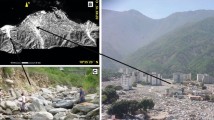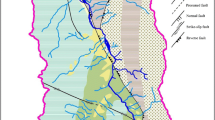Abstract
Over the last three decades, many regional studies in mountain ranges under temperate climate revealed that it is possible to discriminate debris-flow and fluvial fans from morphometric indicators measured at the scale of the catchment and the fan itself. The most commonly used indicators are the Melton index (R), a normalized index of the gravitational energy of the catchment, and the fan slope (S). A wide range of thresholds have been proposed for discriminating purpose, but these are generally based on a small population of catchments and may be highly influenced by ambiguous fans included in the data set. A database of 620 upland catchments from several mountain ranges under temperate climate was compiled from the literature to propose robust discriminant morphometric thresholds for debris-flow versus fluvial responses. Linear discriminant analysis (LDA) and logistic regression (LR) were performed using the whole data set, and a leave-one-out cross-validation was used to evaluate performances of the models. Sensitivity and specificity scores obtained for LDA and LR were 0.96 and 0.73, and 0.95 and 0.75, respectively. It is also shown that the channel slope above which debris-flow is observed decreases with the gravitational energy of the catchment. Limitations of the morphometric discrimination are discussed.






Similar content being viewed by others
References
Beguería S (2006) Validation and evaluation of predictive models in hazard assessment and risk management. Nat Hazards 37(3):315–329
Blair T, McPherson J (1994) Alluvial fans and their natural distinction from rivers based on morphology, hydraulic processes, sedimentary processes, and facies assemblages. J Sediment Res A 64(3):450–489
Calvache ML, Viseras C, Ferndez J (1997) Controls on fan development—evidence from fan morphometry and sedimentology; Sierra Nevada SE Spain. Geomorphology 21(1):69–84
Ceriani M, Crosta G, Frattini P, Quattrini S (2000) Evaluation of hydrogeological hazard on alluvial fans. In: Conference proceedings interpraevent 2000—Villach/Austria, pp 213–225
Crosta GB, Frattini P (2004) Controls on modern alluvial fan processes in the central Alps, Northern Italy. Earth Surf Proc Land 29(3):267–293
D’Agostino V, Marchi L (2001) Debris flow magnitude in the Eastern Italian Alps: data collection and analysis. Phys Chem Earth Pt C 26(9):657–663
De Scally F, Owens I (2004) Morphometric controls and geomorphic responses on fans in the southern Alps New Zealand. Earth Surf Proc Land 29(3):311–322
De Scally F, Owens I, Louis J (2010) Controls on fan depositional processes in the schist ranges of the Southern Alps New Zealand and implications for debris-flow hazard assessment. Geomorphology 122(1–2):99–116
Gomez-Villar A, Garcia-Ruiz JM (2000) Surface sediment characteristics and present dynamics in alluvial fans of the central Spanish Pyrenees. Geomorphology 34(3–4):127–144
Harvey AM (1984) Debris flows and fluvial deposits in Spanish Quaternary alluvial fans: implications for fan morphology. In: Koster EH, Steel RJ (eds) Gravel and conglomerates. Canadian Society of Petroleum Geologists Memoir no. 10, pp 123–132
Hungr O (2008) Simplified models of spreading flow of dry granular material. Can Geotech J (45):1156–1168
Hungr O, Evans SG, Bovis MG, Hutchinson JN (2001) A review of the classification of landslides of the flow type. EEG 7(3):221–238
Hürlimann M, Copons R, Altimir J (2006) Detailed debris flow hazard assessment in Andorra: a multidisciplinary approach. Geomorphology 78(3–4):359–372
Jackson L, Kostaschuk R, MacDonald G (1987) Identification of debris flow hazard on alluvial fans in the Canadian Rocky Mountains. In: Costa JE, Wieckzorek GF (eds) Debris flows/avalanches: Geol Soc Am, Reviews in Engineering Geology, vol 7, pp 115–124
Jakob M (2005) Debris-flow hazard analysis. In: Jakob M, Hungr O (eds) Debris-flow hazards and related phenomena. Springer-Praxis, Berlin, pp 411–443
Jiménez-Valverde A, Lobo JM, Hortal J (2009) The effect of prevalence and its interaction with sample size on the reliability of species distribution models. Commun Ecol 10(2):196–205
Jordan P (2007) Kemp Creek Fire N70171 Post-Wildfire Risk Analysis. Technical report. BC Ministry of Forests and Range: Kootenay Lake Forest District Southern Interior Forest Region and Southeast Fire Centre, p 12
Kostaschuk R, MacDonald GM, Putnam PE (1986) Depositional process and alluvial fan-drainage basin morphometric relationships near Banff Alberta Canada. Earth Surf Proc Land 11(5):471–484
Kovanen DJ, Slaymaker O (2008) The morphometric and stratigraphic framework for estimates of debris flow incidence in the North Cascades foothills Washington State USA. Geomorphology 99(1–4):224–245
Lenzi M (2000) Detailed report of contractor for first progress meeting. Technical report. University of Padova. Department of Land and Agro-forest environments—Water resources division, p 80
Liébault F (2003) Les rivières torrentielles des montagnes drômoises : évolution contemporaine et fonctionnement géomorphologique actuel (massifs du Diois et des Baronnies). PhD thesis. Université Lumière Lyon 2, p 358
Malet JP, Maquaire O, Locat J, Remaitre A (2004) Assessing debris flow hazards associated with slow moving landslides: methodology and numerical analyses. Landslides 1(1):83–90
Mambretti S (2009) Uncertainities in Hydraulic Structures Designing and Management: an Overview. Technical report. DIIAR—Hydraulic Engineering Politecnico di Milano Italy, p 9
Mangeney A, Roche O, Hungr O, Mangold N, Faccanoni G, Lucas A (2010) Erosion and mobility in granular collapse over sloping beds. J Geophys Res Earth Surf 115(3):1–21
Mao L, Cavalli M, Comiti F, Marchi L, Lenzi M, Arattano M (2009) Sediment transfer processes in two Alpine catchments of contrasting morphological settings. J Hydrol 364(1–2):88–98
Marchi L, Brochot S (2000) Les cônes de déjection torrentiels dans les Alpes françaises morphométrie et processus de transport solide torrentiel. Revue de Géographie Alpine 88(3):23–38
Marchi L, Cavalli M (2007) Procedures for the documentation of historical debris flows: application to the Chieppena Torrent (Italian Alps). Environ Manage 40(3):493–503
Marchi L, Pasuto A, Tecca P (1993) Flow processes on alluvial fans in the Eastern Italian Alps. Z Geomorphol 37(4):447–458
Melton M (1965) The geomorphic and paleoclimatic significance of alluvial deposits in southern Arizona. J Geol 73:1–38
O’Brien RM (2007) A caution regarding rules of thumb for variance inflation factors. Qual Quant 41(5):673–690
Remaitre A (2006) Morphologie et dynamique des laves torrentielles: applications aux torrents des Terres Noires du bassin de Barcelonnette (Alpes du Sud). PhD thesis. Université de Caen, p 487
Rowbotham D, De Scally F, Louis J (2005) The identification of debris torrent basins using morphometric measures derived within a GIS. Geogr Ann A 87(4):527–537
Santos Alonso R (2011) Flujos de los derrubios en la Cornisa Cantábrica: evidencias, modelo de susceptibilidad y relevancia geomorfológica. PhD thesis, Departamento de Geología, p 229
Scheidl C, Rickenmann D (2010) Empirical prediction of debris-flow mobility and deposition on fans. Earth Surf Proc Land 35(2):157–173
Sorriso-Valvo M, Antronico L, Pera EL (1998) Controls on modern fan morphology in Calabria Southern Italy. Geomorphology 24(2–3):169–187
Thénard L (2009) Torrents et torrentialité dans la vallée de la Guisane. Contribution d’une étude géographique à la gestion durable du risque torrentiel à Serre-chevalier (Briançonnais; Hautes-Alpes; France). PhD thesis. Université Lille 1, p 549
Theule JI, Liébault F, Loye A, Laigle D, Jaboyedoff M (2012) Sediment budget monitoring of debris-flow and bedload transport in the Manival Torrent, SE France. Nat Hazard Earth Sys 12(3):731–749
Venables WN, Smith DM and the R Core Team (2012) An introduction to R. Notes on R: a programming environment for data analysis and graphics. Version 2.15.2, p 109
Wells SG, Harvey AM (1987) Sedimentologic and geomorphic variations in storm-generated alluvial fans, Howgill Fells, northwest England. Geol Soc Am Bull 98(2):182–198
Wilford D, Sakals M, Innes J, Sidle R, Bergerud W (2004) Recognition of debris flow debris flood and flood hazard through watershed morphometrics. Landslides 1(1):61–66
Xue J-H, Titterington DM (2008) Do unbalanced data have a negative effect on LDA? Pattern Recogn 41(5):1558–1571
Acknowledgments
This research is a part of the EU Interreg Alpine Space PARAmount project (“imProved Accessibility: Reliability and security of Alpine transport infrastructure related to mountainous hazards in a changing climate”) and CPER PACA Rhytmme project. The authors thank Lise Vaudor for her advices with statistical processing, Aurélie Carlin for her help with database compilation and preliminary analysis on the subject, and the ISIG platform at ENS of Lyon for material support. This paper benefits from comments by three anonymous reviewers.
Author information
Authors and Affiliations
Corresponding author
Rights and permissions
About this article
Cite this article
Bertrand, M., Liébault, F. & Piégay, H. Debris-flow susceptibility of upland catchments. Nat Hazards 67, 497–511 (2013). https://doi.org/10.1007/s11069-013-0575-4
Received:
Accepted:
Published:
Issue Date:
DOI: https://doi.org/10.1007/s11069-013-0575-4




